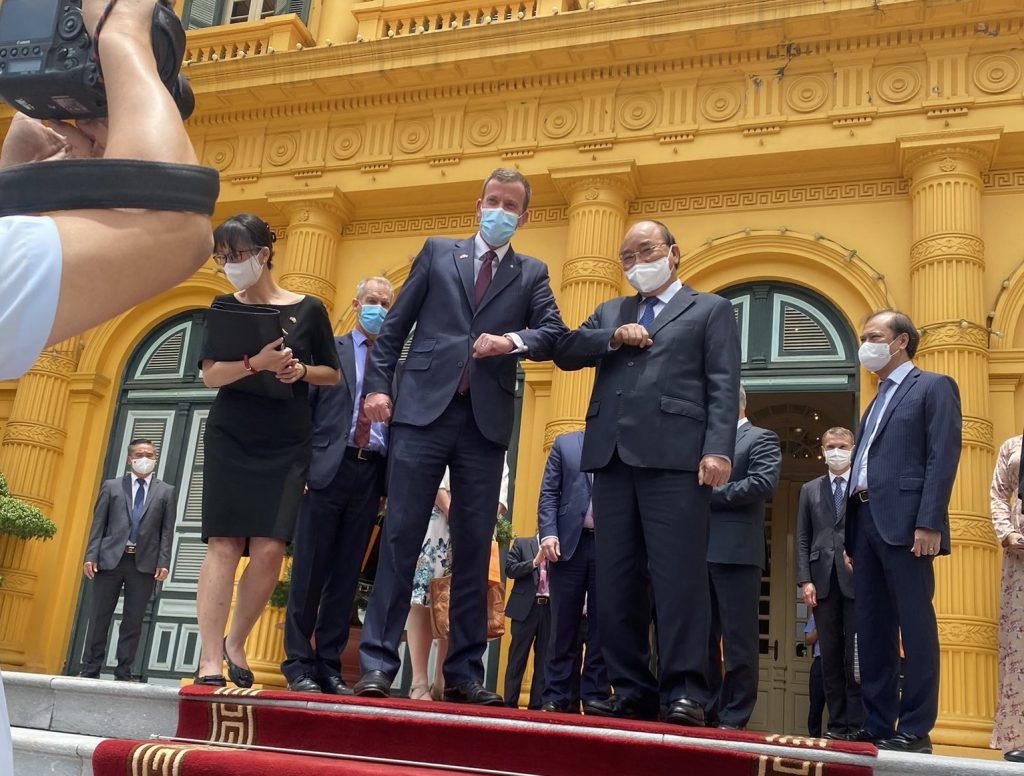
Australia must diversify its economic and strategic relations with its neighbours in Southeast Asia. Trade Minister Dan Tehan’s visit to Vietnam last month to shore up economic ties came while Australian exporters continued to suffer from China’s trade sanctions. Vietnam is becoming an attractive option for Australia’s trade diversification efforts and as a strategic partner. Here’s why it deserves more attention.
Like Australia, Vietnam is a champion of regional trade integration and the rules-based economic architecture in the Indo-Pacific region. It has demonstrated this through its advocacy for major trade efforts. Also like Australia, it is a member of the Comprehensive and Progressive Agreement for Trans-Pacific Partnership (CPTPP). Vietnam was instrumental in the pursuit of CPTPP in the wake of the demise of its predecessor agreement, the Trans-Pacific Partnership, after the US withdrew. Its most recent contribution is the completion of the 15-member Regional Comprehensive Economic Partnership (RCEP), signed in November 2020 while Vietnam was chair of ASEAN.
Its commitment to trade liberalisation makes Vietnam a standout economic partner for Australia. This also means Australia and Vietnam are partners together in the framework of agreements which define the Indo-Pacific economic sphere. RCEP and CPTPP are tools for Australia to pursue diversification with Vietnam. There are opportunities for trade expansion to help solve some of the supply-chain risks that exist in the region.
In their discussion, Tehan and Vietnamese Deputy Prime Minister Pham Binh Minh touched on one, the supply of rare-earth elements. China has long been the dominant extractor and processor of rare earths, with an 80% share of the market. Governments are concerned that control of these critical materials will be used as a geopolitical lever. Using CPTPP and RCEP as a platform, Canberra and Hanoi can develop a supply-chain model in which Australia mines and does initial rare-earths processing and Vietnam undertakes advanced processing before the final product stage.
On top of these trade and investment agreements, Australia and Vietnam share other instruments for cooperation. The Australia–Vietnam strategic partnership signed in 2018 includes a focus on security and defence, as well as economic cooperation. It commits both countries to building strategic relations, particularly security cooperation and reaffirms the importance of their defence ministers’ and ‘2+2’ dialogues. It also establishes an annual ministerial-level forum for identifying opportunities to expand trade and investment.
This exchange between senior trade officials is a valuable opportunity for Australia and Vietnam to plan next steps to realise their bilateral economic goals: doubling investment and becoming top 10 trade partners. During his visit, Tehan met with other top members of the politburo, Vietnam’s key decision-making body, including President Nguyen Xuan Phuc and the head of the Central Economic Committee and a former industry and trade minister, Tran Tuan Anh. The holding of such high-level meetings signalled the esteem with which Vietnam holds its relations with Australia.
All of this engagement exists at the national level, but there’s also a logic for establishing closer cooperation at the subnational level. A recently established provincial-level link for fostering closer ties was signed in September last year between the governments of Western Australia and Ba Ria – Vung Tau province, with economic cooperation a key pillar of their memorandum of understanding.
Ba Ria – Vung Tau is a coastal province and part of the greater Ho Chi Minh City metropolitan area, a region populated by 22 million people that is becoming an important industrial hub. It already hosts industries linked to Western Australia, a testament to the commitment of Vietnam, and the province, to attracting foreign investment.
Interflour, a joint venture between WA’s CBH Group and Indonesia’s Salim Group, has a grain port at Cai Mep. Across the bay, the WA-based commercial and defence shipbuilder Austal opened a yard in 2018. BlueScope Steel also has operations in the province. These companies are on hand to pass their invaluable business and policy knowledge of Vietnam on to other Australian companies seeking to set up in the province.
With all these frameworks in place and no major bilateral irritants to resolve, the main constraint on closer Australia–Vietnam ties is the Covid-19 pandemic. Restricted international travel has curbed vital people-to-people exchanges that support the development of strategic ties. This year hasn’t brought any relief; indeed, Vietnam is facing its worst outbreak since the pandemic began. Australia’s provision of 1.5 million doses of the AstraZeneca vaccine and $40 million to support the rollout in Vietnam is an important gesture bringing some hope that the sooner both countries vaccinate, the sooner they can open their borders and reconnect to form a deeper partnership.

